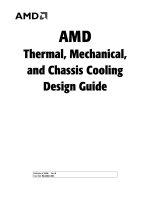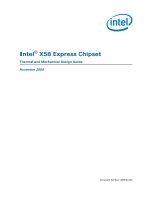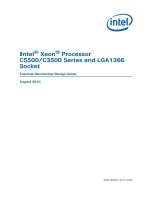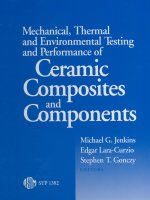Intel ® X58 Express Chipset Thermal and Mechanical Design Guide pot
Bạn đang xem bản rút gọn của tài liệu. Xem và tải ngay bản đầy đủ của tài liệu tại đây (693.9 KB, 42 trang )
Document Number: 320840-003
Intel
®
X58 Express Chipset
Thermal and Mechanical Design Guide
November 2009
2 Thermal and Mechanical Design Guide
INFORMATION IN THIS DOCUMENT IS PROVIDED IN CONNECTION WITH INTEL® PRODUCTS. NO LICENSE, EXPRESS OR IMPLIED,
BY ESTOPPEL OR OTHERWISE, TO ANY INTELLECTUAL PROPERTY RIGHTS IS GRANTED BY THIS DOCUMENT. EXCEPT AS
PROVIDED IN INTEL'S TERMS AND CONDITIONS OF SALE FOR SUCH PRODUCTS, INTEL ASSUMES NO LIABILITY WHATSOEVER,
AND INTEL DISCLAIMS ANY EXPRESS OR IMPLIED WARRANTY, RELATING TO SALE AND/OR USE OF INTEL PRODUCTS INCLUDING
LIABILITY OR WARRANTIES RELATING TO FITNESS FOR A PARTICULAR PURPOSE, MERCHANTABILITY, OR INFRINGEMENT OF ANY
PATENT, COPYRIGHT OR OTHER INTELLECTUAL PROPERTY RIGHT. Intel products are not intended for use in medical, life saving, or
life sustaining applications.
Intel may make changes to specifications and product descriptions at any time, without notice.
Designers must not rely on the absence or characteristics of any features or instructions marked “reserved” or “undefined.” Intel
reserves these for future definition and shall have no responsibility whatsoever for conflicts or incompatibilities arising from future
changes to them.
The Intel
®
X58 Express Chipset IOH may contain design defects or errors known as errata which may cause the product to deviate
from published specifications. Current characterized errata are available on request.
Contact your local Intel sales office or your distributor to obtain the latest specifications and before placing your product order.
Intel and the Intel logo are trademarks of Intel Corporation in the U.S. and other countries.
* Other brands and names may be claimed as the property of others.
Copyright © 2008-2009, Intel Corporation.
Thermal and Mechanical Design Guide 3
Contents
1Introduction 7
1.1 Design Flow 7
1.2 Definition of Terms 8
1.3 Reference Documents 8
2 Packaging Technology 9
2.1 Non-Critical to Function Solder Joints 11
2.2 Package Mechanical Requirements 12
3 Thermal Specifications 13
3.1 Thermal Design Power (TDP) 13
3.2 Case Temperature 13
4 Thermal Metrology 15
4.1 Die Temperature Measurements 15
4.1.1 Zero Degree Angle Attach Methodology 15
4.2 Airflow Characterization 17
5 ATX Reference Thermal Solution 19
5.1 Operating Environment 19
5.2 Board-Level Components Keepout Dimensions 22
5.3 Reference Heatsink Thermal Solution Assembly 23
5.4 Mechanical Design Envelope 23
5.4.1 Extruded Heatsink Profiles 23
5.4.2 Heatsink Orientation 23
5.4.3 Thermal Interface Material 23
5.4.4 Heatsink Clip 24
5.4.5 Anchor 24
5.5 Reliability Guidelines 25
5.6 Alternate Heatsink Thermal Solution Assembly 25
5.7 Alternate Heatsink Mechanical Design Envelope 27
5.7.1 Extruded Heatsink Profiles 27
5.7.2 Heatsink Clip 27
5.7.3 Anchor 28
5.7.4 Ramp Retainer 28
5.7.5 Thermal Interface Material 28
A Thermal Solution Component Suppliers 29
B Mechanical Drawings for Package & Reference Thermal Solution 31
C Mechanical Drawings for Alternate Thermal Solution 35
4 Thermal and Mechanical Design Guide
Figures
1-1 Thermal Design Process 7
2-1 IOH Package Dimensions (Top View) 9
2-2 IOH Package Dimensions (Side View) 9
2-3 IOH Package Dimensions (Bottom View) 10
2-4 Non-Critical to Function Solder Joints 11
4-1 Thermal Solution Decision Flow Chart 16
4-2 Zero Degree Angle Attach Heatsink Modifications 16
4-3 Zero Degree Angle Attach Methodology (Top View) 17
4-4 Airflow and Temperature Measurement Locations 17
5-1 ATX Boundary Conditions 20
5-2 Side View of ATX Boundary Conditions 21
5-3 Heatsink Board Component Keepout 22
5-4 Reference Heatsink Assembly 23
5-5 Alternate Heatsink Assembly 25
5-6 Retention Mechanism Component Keepout Zones for Alternate Heatsink 26
5-7 Retention Mechanism Component Keepout Zones for Alternate Heatsink 27
B-1 IOH Package Drawing 32
B-2 Heatsink Extrusion Drawing 33
B-3 Z-Clip Wire 34
C-1 Heatsink Extrusion Drawing 36
C-2 Heat Sink Extrusion Detail 37
C-3 Anchor 38
C-4 Ramp Retainer - Page 1 39
C-5 Ramp Retainer - Page 2 40
C-6 Wire Preload Clip 41
Tables
3-1 Intel
®
X58 Express Chipset IOH Thermal Design Power 13
3-2 Intel
®
X58 Express ChipsetThermal Specification 13
5-1 IOH Thermal Solution Boundary Conditions 20
5-2 Honeywell PCM45 F* TIM Performance as a Function of Attach Pressure 24
5-3 Reliability Guidelines 25
A-1 Reference Heatsink Enabled Components 29
A-2 Alternate Heatsink - Preload Wavesolder Heatsink (PWHS) Components 29
A-3 Supplier Contact Information 29
B-1 Mechanical Drawing List 31
C-1 Mechanical Drawing List 35
Thermal and Mechanical Design Guide 5
Revision History
§
Revision
Number
Description Date
-001 • Initial release November 2008
-002
• Updated idle power
• Updated Reference Document link
March 2009
-003 • Updated idle power November 2009
6 Thermal and Mechanical Design Guide
Thermal and Mechanical Design Guide 7
Introduction
1 Introduction
The goals of this document are to:
• Outline the thermal and mechanical operating limits and specifications for the
Intel
®
X58 Express Chipset IOH.
• Describe reference thermal solutions that meet the specifications of the Intel
®
X58
Express Chipset IOH.
Properly designed thermal solutions provide adequate cooling to maintain the Intel
®
X58 Express Chipset IOH case temperatures at or below thermal specifications. This is
accomplished by providing a low local-ambient temperature, ensuring adequate local
airflow, and minimizing the case to local-ambient thermal resistance. By maintaining
the IOH case temperature at or below the specified limits, a system designer can
ensure the proper functionality, performance, and reliability of the IOH. Operation
outside the functional limits can cause data corruption or permanent damage to the
component.
The simplest and most cost-effective method to improve the inherent system cooling
characteristics is through careful chassis design and placement of fans, vents, and
ducts. When additional cooling is required, component thermal solutions may be
implemented in conjunction with system thermal solutions. The size of the fan or
heatsink can be varied to balance size and space constraints with acoustic noise.
This document addresses thermal design and specifications for the Intel
®
X58 Express
Chipset IOH component only. For thermal design information on other chipset
components, refer to the respective component TMDG. For the ICH10, refer to the
Intel
®
I/O Controller Hub 10 (ICH10) Thermal and Mechanical Design Guidelines.
Note: Unless otherwise specified, the term “IOH” refers to the Intel
®
X58 Express Chipset
IOH.
1.1 Design Flow
To develop a reliable, cost-effective thermal solution, several tools have been provided
to the system designer. Figure 1-1 illustrates the design process implicit to this
document and the tools appropriate for each step.
Figure 1-1. Thermal Design Process
Thermal Model
Thermal Model User's Guide
Step 1: Thermal
Simulation
Thermal Reference
Mechanical Reference
Step 2: Heatsink Selection
Thermal Testing Software
Software User's Guide
Step 3: Thermal Validation
Introduction
8 Thermal and Mechanical Design Guide
1.2 Definition of Terms
1.3 Reference Documents
The reader of this specification should also be familiar with material and concepts
presented in the following documents.
§
Term Description
FC-BGA
Flip Chip Ball Grid Array. A package type defined by a plastic substrate where a die is
mounted using an underfill C4 (Controlled Collapse Chip Connection) attach style. The
primary electrical interface is an array of solder balls attached to the substrate opposite the
die. Note that the device arrives at the customer with solder balls attached.
BLT
Bond Line Thickness. Final settled thickness of the thermal interface material after
installation of heatsink.
Intel
®
QuickPath
Interconnect
The Physical layer of Intel
®
QuickPath interconnect is a link based interconnect
specification for Intel processors, chipset and I/O bridge components.
IOH
Input Output Hub. The IO Controller Hub component that contains the Intel
®
QuickPath
Interface to the processor, and PCI Express* interface. It communicates with the ICH10
over a proprietary interconnect called the Direct Media Interface (DMI).
Intel ICH10
I/O Controller Hub 10.
T
case_max
Die temperature allowed. This temperature is measured at the geometric center of the top
of the die.
TDP
Thermal design power. Thermal solutions should be designed to dissipate this target power
level. TDP is not the maximum power that the IOH can dissipate.
Title Location
Intel
®
X58 Express Chipset Datasheet />PDF/datasheet/320839.pdf
Intel
®
I/O Controller Hub ICH10 Thermal Mechanical Design Guidelines />chipsets/
designex/319975.pdf
Thermal and Mechanical Design Guide 9
Packaging Technology
2 Packaging Technology
The IOH uses a 37.5 mm, 8-layer flip chip ball grid array (FC-BGA) package (see
Figure 2-1, Figure 2-2, and Figure 2-3). The complete package drawing can be found at
Figure B-1. For information on the ICH10 package, refer to the Intel
®
I/O Controller
Hub 10 (ICH10) Family Thermal and Mechanical Design Guidelines.
Figure 2-1. IOH Package Dimensions (Top View)
Figure 2-2. IOH Package Dimensions (Side View)
Die
37.5 mm.
37.5 mm.
13.8 mm.
10.6 mm
Handling
Exclusion
Area
- C -
See Note 3
Seating Plane
See note 1
See note 4
Die
NOTES:
1. Primary datum-C and seating plan are defined by the spherical crowns of the solder balls (shown before motherboard attach)
2. All dimensions and tolerances conform to ANSI Y14.5M-1994
3. BGA has a pre-SMT height of 0.5±0.10 mm. Top of die above the motherboard after reflow is 2.36 ± 0.24 mm.
4. Shown before motherboard attach; FCBGA has a convex (dome shape) orientation before reflow and is expected to have a
slightly concave (bowl shaped) orientation after reflow
0.20
0.20
0.5 ± 0.1 mm
2.48 ±
0.24 mm
1.98 ±
0.14 mm
Substrate
0.82 ±
0.05 mm
Packaging Technology
10 Thermal and Mechanical Design Guide
Notes:
1. All dimensions are in millimeters.
2. All dimensions and tolerances conform to ANSI Y14.5M-1994.
Figure 2-3. IOH Package Dimensions (Bottom View)
37.5 + 0.05
2822 26242018161412108642 36343230
A
AJ
AE
AC
AA
U
R
N
L
J
G
E
C
W
AG
AL
AN
AR
AH
AF
AD
AB
Y
V
T
P
M
K
H
F
D
AK
AM
AP
AT
B
A
B
37.5 + 0.05
C
A
0.2
35x 1.016
35.56
35.56
35X 1.016
11 25232119171513975312729333531
C
0.2
Thermal and Mechanical Design Guide 11
Packaging Technology
2.1 Non-Critical to Function Solder Joints
Intel has defined selected solder joints of the IOH as non-critical to function (NCTF)
when evaluating package solder joints post environmental testing. The IOH signals at
NCTF locations are typically redundant ground or non-critical reserved, so the loss of
the solder joint continuity at end of life conditions will not affect the overall product
functionality. Figure 2-4 identifies the NCTF solder joints of the IOH package.
Figure 2-4. Non-Critical to Function Solder Joints
1 3 5 7 9 11 13 15 17 19 21 23 25 27 29 31 33 35
2 4 6 8 10 12 14 16 18 20 22 24 26 28 30 32 34 36
AT
AR
AP
AN
AM
AL
AK
AJ
AH
AG
AF
AE
AD
AC
AB
AA
Y
W
V
U
T
R
P
N
M
L
K
J
H
G
F
E
D
C
B
A
Packaging Technology
12 Thermal and Mechanical Design Guide
2.2 Package Mechanical Requirements
The IOH package has a bare die that is capable of sustaining a maximum static normal
load of 15 lbf (67N). These mechanical load limits must not be exceeded during
heatsink installation, mechanical stress testing, standard shipping conditions, and/or
any other use condition.
Note: The heatsink attach solutions must not induce continuous stress to the IOH package
with the exception of a uniform load to maintain the heatsink-to-package thermal
interface.
Note: These specifications apply to uniform compressive loading in a direction perpendicular
to the die top surface.
Note: These specifications are based on limited testing for design characterization. Loading
limits are for the package only.
§
Thermal and Mechanical Design Guide 13
Thermal Specifications
3 Thermal Specifications
3.1 Thermal Design Power (TDP)
Analysis indicates that real applications are unlikely to cause the IOH component to
consume maximum power dissipation for sustained time periods. Therefore, in order to
arrive at a more realistic power level for thermal design purposes, Intel characterizes
power consumption based on known platform benchmark applications. The resulting
power consumption is referred to as the Thermal Design Power (TDP). TDP is the target
power level to which the thermal solutions should be designed. TDP is not the
maximum power that the IOH can dissipate.
For TDP specifications, see Table 3-1 for the Intel
®
X58 Express Chipset IOH. FC-BGA
packages have poor heat transfer capability into the board and have minimal thermal
capability without thermal solution. Intel recommends that system designers plan for a
heatsink with the IOH.
Notes:
1. These specifications are based on silicon measurements.
2. TDP assumes the following configuration: 36 PCIe* Gen. 2.0 lanes configured as 2 x16 PEG and 1 x4 PCIe,
the DMI link to the ICH and the Intel
®
QuickPath Interconnect operating at 6.4 GT /s.
3. TDP assumes the following configuration: 36 PCIe* Gen. 2.0 lanes configured as 2 x16 PEG and 1 x4 PCIe,
the DMI link to the ICH and the Intel QuickPath Interconnect operating at 4.8 GT /s.
4. The idle power assumes the case temperature is at or below 65 °C.
3.2 Case Temperature
To ensure proper operation and reliability of the IOH, the case temperature must
comply with the thermal profile as specified in Table 3-2. System and/or component
level thermal solutions are required to maintain these temperature specifications. Refer
to Chapter 4 for guidelines on accurately measuring package case temperatures.
Note: The reference thermal solution is described in Chapter 5, “ATX Reference Thermal Solution”.
§
Table 3-1. Intel
®
X58 Express Chipset IOH Thermal Design Power
Product TDP Idle Notes
IOH 36S 24.1 W 13.0 W 1, 2, 4
IOH 36S 20–24 W 13.0 W 1, 3, 4
Table 3-2. Intel
®
X58 Express ChipsetThermal Specification
Parameter Value
Tcase_max 100 °C
Tcase_min 5 °C
Tcontrol 95 °C
Thermal Specifications
14 Thermal and Mechanical Design Guide
Thermal and Mechanical Design Guide 15
Thermal Metrology
4 Thermal Metrology
The system designer must make temperature measurements to accurately determine
the thermal performance of the system. Intel has established guidelines for proper
techniques to measure the IOH die temperatures. Section 4.1 provides guidelines on
how to accurately measure the IOH die temperatures. The flowchart in Figure 4-1
offers useful guidelines for thermal performance and evaluation.
4.1 Die Temperature Measurements
To ensure functionality and reliability, the T
case
of the IOH must be maintained at or
between the maximum/minimum operating range of the temperature specification as
noted in Table 3-2. The surface temperature at the geometric center of the die
corresponds to T
case
. Measuring T
case
requires special care to ensure an accurate
temperature measurement.
Temperature differences between the temperature of a surface and the surrounding
local ambient air can introduce errors in the measurements. The measurement errors
could be due to a poor thermal contact between the thermocouple junction and the
surface of the package, heat loss by radiation and/or convection, conduction through
thermocouple leads, and/or contact between the thermocouple cement and the
heatsink base (if a heatsink is used). For maximum measurement accuracy, only the 0°
thermocouple attach approach is recommended.
4.1.1 Zero Degree Angle Attach Methodology
1. Mill a 3.3 mm (0.13 in.) diameter and 1.5 mm (0.06 in.) deep hole centered on the
bottom of the heatsink base.
2. Mill a 1.3 mm (0.05 in.) wide and 0.5 mm (0.02 in.) deep slot from the centered
hole to one edge of the heatsink. The slot should be parallel to the heatsink fins
(see Figure 4-2).
3. Attach thermal interface material (TIM) to the bottom of the heatsink base.
4. Cut out portions of the TIM to make room for the thermocouple wire and bead. The
cutouts should match the slot and hole milled into the heatsink base.
5. Attach a 36 gauge or smaller calibrated K-type thermocouple bead or junction to
the center of the top surface of the die using a high thermal conductivity cement.
During this step, ensure no contact is present between the thermocouple cement
and the heatsink base because any contact will affect the thermocouple reading.
It is critical that the thermocouple bead makes contact with the die (see
Figure 4-3).
6. Attach heatsink assembly to the IOH and route thermocouple wires out through the
milled slot.
Thermal Metrology
16 Thermal and Mechanical Design Guide
NOTE: Not to scale.
Figure 4-1. Thermal Solution Decision Flow Chart
Figure 4-2. Zero Degree Angle Attach Heatsink Modifications
Attach
thermocouples
using recommended
metrology. Setup
the system in the
desired
configuration.
Tdie >
Specification?
No
Yes
Heatsink
Required
Select
Heatsink
End
Start
Run the Power
program and
monitor the
device die
temperature.
Attach device
to board
using normal
reflow
process.
Thermal and Mechanical Design Guide 17
Thermal Metrology
NOTE: Not to scale.
4.2 Airflow Characterization
Figure 4-4 describes the recommended location for air temperature measurements
measured relative to the component. For a more accurate measurement of the average
approach air temperature, Intel recommends averaging temperatures recorded from
two thermocouples spaced about 25 mm [1.0 in] apart. Locations for both a single
thermocouple and a pair of thermocouples are presented.
Figure 4-3. Zero Degree Angle Attach Methodology (Top View)
Cement +
Thermocouple Bead
Die
Thermocouple
Wire
Substrate
Figure 4-4. Airflow and Temperature Measurement Locations
Thermal Metrology
18 Thermal and Mechanical Design Guide
Airflow velocity can be measured using sensors that combine air velocity and
temperature measurements. Typical airflow sensor technology may include hot wire
anemometers. Figure 4-4 provides guidance for airflow velocity measurement locations
which should be the same as used for temperature measurement. These locations are
for a typical JEDEC test setup and may not be compatible with chassis layouts due to
the proximity of the processor to the IOH. The user may have to adjust the locations
for a specific chassis. Be aware that sensors may need to be aligned perpendicular to
the airflow velocity vector or an inaccurate measurement may result. Measurements
should be taken with the chassis fully sealed in its operational configuration to achieve
a representative airflow profile within the chassis.
§
Thermal and Mechanical Design Guide 19
ATX Reference Thermal Solution
5 ATX Reference Thermal
Solution
The design strategy for the Intel
®
X58 Express Chipset thermal solution is to reuse a z-
clip heatsink originally designed for the Intel
®
965 Express Chipset. This is a change
from the previous revision of this document. The change is based on structural analysis
and testing for solder joint reliability that showed minimal risk for the critical to
function solder joints.
The Preload Wave Solder Heatsink (PWHS) documented in the previous revision of this
document is now listed as an alternate thermal solution for designs that deviate from
the core layout for the position of the IOH with respect to the processor, chassis
mounting holes or IOH pad sizes.
This section describes the overall requirements for the ATX heatsink reference thermal
solution including critical-to-function dimensions, operating environment, and
validation criteria. Other chipset components may or may not need attached thermal
solutions depending on your specific system local-ambient operating conditions.
5.1 Operating Environment
The IOH reference thermal solution is dependent on the exhaust air flow from the
processor thermal solution. This airstream is assumed to be approaching the heatsink
at a 30° angle from the processor thermal solution, see Figure 5-1 and Figure 5-2 for
more details.
This airflow can be achieved by using a processor heatsink providing omni-directional
airflow, such as a radial fin or "X" pattern heatsink. Such a heatsink can deliver airflow
to the IOH and other areas like the voltage regulator. In addition, IOH board placement
should ensure that the IOH heatsink is within the air exhaust area of the processor
heatsink.
The local ambient air temperature, T
A
, at the IOH heatsink inlet is dependent on the
processor power dissipation, see Table 5-1 for assumed conditions. The thermal
designer must carefully select the location to measure airflow to get a representative
sampling. These environmental assumptions are based on a 35 °C maximum system
external temperature measured at sea level.
Finally, heatsink orientation alone does not ensure that airflow speed will be achieved.
The system integrator should use analytical or experimental means to determine
whether a system design provides adequate airflow speed for a particular to the
heatsink.
Three system level boundary conditions will be used to determine IOH thermal solution
requirements identified as Case 1 through 3.
• Low external ambient (25 °C)/ idle power for the components (Case 3). This covers
the system idle acoustic condition.
• Low external ambient (25 °C)/ TDP for the components (Case 2). The processor
thermal solution fan speed is limited by the thermistor in the fan hub.
• High external ambient (35 °C)/ TDP for the components (Case 1). This covers the
maximum processor thermal solution fan speed condition.
ATX Reference Thermal Solution
20 Thermal and Mechanical Design Guide
Notes:
1. Target Psi-ca for Case 3 is based on the idle conditions listed in Table 3-1.
Table 5-1. IOH Thermal Solution Boundary Conditions
Case
External
Ambient
IOH
Power
Processor
Power
T
A-Local
Target
Psi-ca
Airflow
1 35 °C TDP TDP 56 °C 1.83 °C/W 756 LFM[3.8 m/S]
2 25 °C TDP TDP 55 °C 1.86 °C/W 420 LFM[2.1m/S]
3 25 °C Idle Idle 37 °C 3.29 °C/W 163 LFM[0.83m/S]
Figure 5-1. ATX Boundary Conditions
East Face:
•4.17” wide airflow
inlet (from z=0.0” to
z=1.97”), open above
z=1.97”
• flow into inlet plane
ducted at 30° angle
onto motherboard
with uniform airflow
entering duct
North Face: Open
Top Face: Open
West Face:
4.51” tall blockage
from add-in card
except for noted 1.5”
x 0.63” bottom gap,
open above 4.51”
South Face:
1.40” tall blockage
from DIMMs except
for noted 0.67” gap,
open above 1.40”
1.25”
1.5”
2.8”
4.17”
1.5” (location of 0.63” bottom gap)
0.67” gap
5.00”
0.52” open gap
0.31” open gap
Thermal and Mechanical Design Guide 21
ATX Reference Thermal Solution
Figure 5-2. Side View of ATX Boundary Conditions
ATX Reference Thermal Solution
22 Thermal and Mechanical Design Guide
5.2 Board-Level Components Keepout Dimensions
The location of hole patterns and keepout zones for the reference thermal solution are
shown in Figure 5-3.
Figure 5-3. Heatsink Board Component Keepout
50
1.969[]
67.02
2.639[]
60.92
2.398[]
47
1.850[]
4X 8.76
.345[]
4X 5.08
.200[]
4X 4.19
.165[]
4X 2.095
.082[]
2X 3.3
.130[]
2X 2.29
.090[]
2X 5.72
.225[]
2X 2.54
.100[]
44
1.732[]
COMPONENT CENTER
MAX 1.27 [.050]
COMPONENT HEIGHT
(NON-MCH COMPONENTS)
NO COMPONENTS THIS AREA
NOTES:
1. HOLE PLACEMENT FABRICATION
TOLERANCE PER INTEL 454979, CLASS 1,2,3
2. HEATSINK COMPONENT HEIGHT NOT TO EXCEED
38.1MM ABOVE MOTHERBOARD SURFACE.
MAX 1.78 [.070] COMPONENT HEIGHT
MAX 1.55 [.060]
COMPONENT HEIGHT
(NON-MCH COMPONENTS)
SEE DETAIL A
SEE DETAIL B
DETAIL A
SCALE 8
4X 0.97 [0.038] PLATED THRU HOLE
4X 1.42 [0.056] TRACE KEEPOUT
DETAIL B
SCALE 6
Thermal and Mechanical Design Guide 23
ATX Reference Thermal Solution
5.3 Reference Heatsink Thermal Solution Assembly
The reference thermal solution for the IOH is a passive aluminum extruded heatsink
with a preapplied thermal interface material and a z-clip to attach the extrusion to
anchors on the board.
The heatsink is attached to the motherboard by assembling the anchors into the board
and sending the board through the wave solder. After wavesolder the heatsink is
positioned on the IOH and the z-clips snapped into the anchors.
5.4 Mechanical Design Envelope
While each design may have unique mechanical volume and height restrictions or
implementation requirements, the height, width, and depth constraints typically placed
on the Intel
®
X58 Express Chipset IOH thermal solution are shown in Figure 5-3. The
maximum height of the installed IOH thermal solution is approximately 33.7 mm
[1.3 inches].
5.4.1 Extruded Heatsink Profiles
The reference thermal solution uses an extruded heatsink for cooling the IOH.
Appendix A lists a supplier for this extruded heatsink. Other heatsinks with similar
dimensions and increased thermal performance may be available. Full mechanical
drawing of this heatsink is provided in Appendix B.
5.4.2 Heatsink Orientation
Since this solution is based on a unidirectional heatsink, mean airflow direction must be
aligned with the direction of the heatsink fins. The use of an omni-directional processor
heatsink as described in Section 5.1 will facilitate but not ensured adequate air flow.
5.4.3 Thermal Interface Material
A thermal interface material (TIM) provides conductivity between the IHS and heat
sink. The reference thermal solution uses Honeywell PCM45 F*, 0.25 mm (0.010 in.)
thick, 20 mm x 20 mm (0.79 in. x 0.79 in.) square.
Note: Unflowed or “dry” Honeywell PCM45 F has a material thickness of 0.010 inch. The
flowed or “wet” Honeywell PCM45F has a material thickness of ~0.003 inch after it
reaches its phase change temperature.
Figure 5-4. Reference Heatsink Assembly
Z-Clip Anchor
Extrusion
Z-Clip Anchor
Extrusion
ATX Reference Thermal Solution
24 Thermal and Mechanical Design Guide
5.4.3.1 Effect of Pressure on TIM Performance
As mechanical pressure increases on the TIM, the thermal resistance of the TIM
decreases. This phenomenon is due to the decrease of the bond line thickness (BLT).
BLT is the final settled thickness of the thermal interface material after installation of
heatsink. The effect of pressure on the thermal resistance of the Honeywell PCM45 F
TIM is shown in Table 5-2.
Intel provides both End of Line and End of Life TIM thermal resistance values of
Honeywell PCM45F. End of Line and End of Life TIM thermal resistance values are
obtained through measurement on a Test Vehicle similar to Intel
®
X58 Express
Chipset’s physical attributes using an extruded aluminum heatsink. The End of Line
value represents the TIM performance post heatsink assembly while the End of Life
value is the predicted TIM performance when the product and TIM reaches the end of
its life. The heatsink clip provides enough pressure for the TIM to achieve End of Line
and End of Life thermal resistances shown in Figure 5-2.
5.4.4 Heatsink Clip
The reference solution Z-clip is a new design to span the previously defined anchor
locations. It provide a constant preload on the extrusion for the TIM. See Appendix A
for the part number and supplier information. See Appendix B for a mechanical
drawings.
5.4.5 Anchor
The anchor from previous z-clip solutions will be reused. By using anchors that are
separate from the extrusion the solderability of the anchors is improved. The
elimination of the conduction path from pins in the extrusion reduces the chance for
cold solder joints. This design incorporates a 45° bent leads to increase the anchor
attach reliability over time. See Appendix A for the part number and supplier
information. See Appendix B for a mechanical drawings.
Table 5-2. Honeywell PCM45 F* TIM Performance as a Function of Attach Pressure
Pressure on Thermal Solution
and Package Interface (PSI)
Thermal Resistance (°C × in
2
)/W
End of Line End of Life
50 0.533 0.646
Thermal and Mechanical Design Guide 25
ATX Reference Thermal Solution
5.5 Reliability Guidelines
Each motherboard, heatsink and attach combination may vary the mechanical loading
of the component. Based on the end user environment, the user should define the
appropriate reliability test criteria and carefully evaluate the completed assembly prior
to use in high volume. Some general recommendations are shown in Table 5-3.
Notes:
1. It is recommended that the above tests be performed on a sample size of at least twelve assemblies from
three lots of material.
2. Additional pass/fail criteria may be added at the discretion of the user.
5.6 Alternate Heatsink Thermal Solution Assembly
The alternate reference thermal solution for the IOH is a passive extruded heatsink that
uses two ramp retainers, a wire preload clip, and four motherboard anchors with pre-
applied thermal interface. Figure 5-5 through Figure 5-7 shows the reference thermal
solution assembly, associated components, and relevant keepout zones.
The heatsink is attached to the motherboard by assembling the anchors into the board,
placing the heatsink, with the wire preload clip over the IOH and anchors at each of the
corners, and securing the plastic ramp retainers through the anchor loops before
snapping each retainer into the fin gap. Leave the wire preload clip loose in the
extrusion during the wave solder process. The assembly is then sent through the wave
process. Post wave, the wire preload clip is snapped into place on the hooks located on
each of the ramp retainers. The clip provides the mechanical preload to the package. A
thermal interface material is pre-applied to the heatsink bottom over an area which
contacts the package die See Section 5.7.5 for additional details.
Table 5-3. Reliability Guidelines
Test
(1)
Requirement Pass/Fail Criteria
(2)
Mechanical
Shock
3 drops each for + and - directions in each of 3 perpendicular axes
(i.e., total 18 drops)
Profile: 50 g, Trapezoidal waveform, 4.3 m/s [170 in/s] minimum
velocity change
Visual Check and
Electrical Functional
Test
Random
Vibration
Duration: 10 min/axis, 3 axes
Frequency Range: 5 Hz to 500 Hz
Power Spectral Density (PSD) Profile: 3.13 g RMS
Visual Check and
Electrical Functional
Test
THermal
Cycling
• 7500 cycles (on/off) of minimum temperature 27 °C / maximum
temperature 96 °C
• 1400 cycles (on/off) of minimum temperature 35 °C / maximum
temperature 96 °C
• A 15 second dwell at high / low temperature for both test cycles
Thermal Performance
Humidity 85% relative humidity, 55 °C, 576 hours Visual Check
Figure 5-5. Alternate Heatsink Assembly
Anchor
(4x)
Extrusion
Ramp Retainer
(2x)
Clip
Anchor
(4x)
Extrusion
Ramp Retainer
(2x)
Clip









